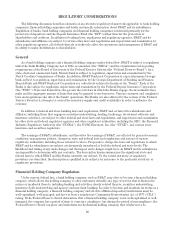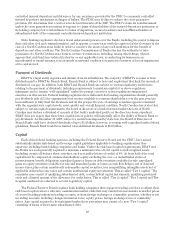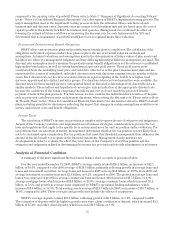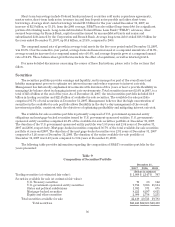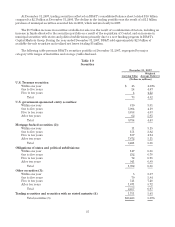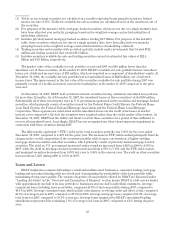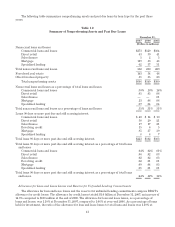BB&T 2007 Annual Report Download - page 34
Download and view the complete annual report
Please find page 34 of the 2007 BB&T annual report below. You can navigate through the pages in the report by either clicking on the pages listed below, or by using the keyword search tool below to find specific information within the annual report.The following is a summary of BB&T’s critical accounting policies that are highly dependent on estimates,
assumptions and judgments. These critical accounting policies are reviewed with the Audit Committee of BB&T’s
Board of Directors on a periodic basis.
Allowance for Loan and Lease Losses and Reserve for Unfunded Lending Commitments
It is the policy of BB&T to maintain an allowance for loan and lease losses and a reserve for unfunded lending
commitments that equal management’s best estimate of probable credit losses that are inherent in the portfolio at
the balance sheet date. Estimates for loan and lease losses are determined by analyzing historical loan and lease
losses, current trends in delinquencies and charge-offs, plans for problem loan and lease administration, the
results of regulatory examinations, and changes in the size, composition and risk assessment of the loan and lease
portfolio. Also included in management’s estimates for loan and lease losses are considerations with respect to the
impact of current economic events, the outcomes of which are uncertain. These events may include, but are not
limited to, fluctuations in overall interest rates, political conditions, legislation that may directly or indirectly
affect the banking industry and economic conditions affecting specific geographical areas and industries in which
BB&T conducts business. The methodology used to determine an estimate for the reserve for unfunded lending
commitments is inherently similar to the methodology utilized in calculating the allowance for loans and leases
adjusted for factors specific to binding commitments, including the probability of funding and exposure at the
time of funding. A detailed discussion of the methodology used in determining the allowance for loan and lease
losses and the reserve for unfunded lending commitments is included in the “Overview and Description of
Business—Allowance for Loan and Lease Losses and Reserve for Unfunded Lending Commitments.”
Valuation of Mortgage Servicing Rights
BB&T has a significant mortgage loan servicing portfolio and related mortgage servicing rights. Mortgage
servicing rights represent the present value of the future net servicing fees from servicing mortgage loans
acquired or originated by BB&T. The methodology used to determine the fair value of mortgage servicing rights
is subjective and requires the development of a number of assumptions, including anticipated prepayments of
loan principal. The value of mortgage servicing rights is significantly affected by mortgage interest rates
available in the marketplace, which influence mortgage loan prepayment speeds. In general, during periods of
declining interest rates, the value of mortgage servicing assets declines due to increasing prepayments
attributable to increased mortgage refinance activity. Conversely, during periods of rising interest rates, the
value of servicing assets generally increases due to reduced refinance activity. BB&T has two classes of mortgage
servicing rights for which it separately manages the economic risk: residential and commercial. Residential
mortgage servicing rights are carried at fair value with changes in fair value recorded as a component of
mortgage banking income each period. BB&T uses various derivative instruments to mitigate the income
statement effect of changes in fair value, due to change in valuation inputs and assumptions, of its residential
mortgage servicing rights. Commercial mortgage servicing rights are carried at lower of cost or market and
amortized over the estimated period that servicing income is expected to be received based on projections of the
amount and timing of estimated future cash flows. The amount and timing of servicing asset amortization is
updated based on actual results and updated projections. Please refer to Note 8 “Loan Servicing” in the “Notes to
Consolidated Financial Statements” for quantitative disclosures reflecting the effect that changes in
management’s assumptions would have on the fair value of mortgage servicing rights.
Intangible Assets
BB&T’s growth in business, profitability and market share over the past several years has been enhanced
significantly by mergers and acquisitions. BB&T’s mergers and acquisitions are accounted for using the purchase
method of accounting. Under the purchase method, BB&T is required to record the assets acquired, including
identified intangible assets, and liabilities assumed at their fair value, which often involves estimates based on
third party valuations, such as appraisals, or internal valuations based on discounted cash flow analyses or other
valuation techniques, which are inherently subjective. The amortization of identified intangible assets is based
upon the estimated economic benefits to be received, which is also subjective. These estimates also include the
establishment of various accruals and allowances based on planned facility dispositions and employee severance
considerations, among other acquisition-related items. In addition, purchase acquisitions typically result in
goodwill, which is subject to ongoing periodic impairment tests based on the fair value of net assets acquired
34




